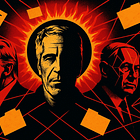Bible Bashing: Jesus vs Project 2025
From Constantine’s Creed to Trump’s Playbook: How Empire Twists Scripture to Serve Power
In April 2022, an American conservative think tank called the Heritage Foundation quietly launched an initiative called Project 2025.
Over the following year, more than a hundred conservative organizations and over four hundred contributors spent months drafting what would become a nearly one thousand page manual for seizing and reshaping the machinery of American government; a playbook laying out how a Republican president could gut the civil service, consolidate executive power, and impose a so-called “biblical worldview” on federal policy.
During the 2024 presidential election, Donald Trump professed to know nothing about Project 2025, but since returning to power, his administration has been executing the playbook point by point: dismantling federal agencies, stripping workplace protections, rolling back environmental safeguards, and seeking to criminalize abortion nationwide, and eliminate LGBTQ rights. The plan also proposes filling thousands of civil service roles with partisan loyalists, handing the president near-absolute control over the executive branch, and that’s now playing out in real time.
In a country founded as a secular experiment in self-government, where barely sixty percent of Americans identify as Christian and fewer than a third attend church regularly, the imposition of a “biblical worldview” is unconstitutional at best. And when you explore the ideology behind Project 2025 - men at the head of households, women in submission, marriage defined only as heterosexual, punishment over mercy, hierarchy over equality - it bears little resemblance to the teachings of Jesus, who, according to the Bible, preached mercy, justice, and love.
Now, more than ever, Americans are asking why a book written thousands of years ago is being used to dictate U.S. policy. Is it the definitive word of God, an infallible document of truth? Who wrote it, who compiled it, and why is it now carrying so much political weight?
To answer those questions, we have to look back thousands of years, to when ink was first put to parchment to tell the story of a wandering Jewish teacher from Galilee, and to the many emperors, bishops, kings, preachers, profiteers, and conmen who have all reshaped that story on its long journey to Project 2025.
This piece is written in the spirit of love, not mockery. It is intended to shine a light on how power has bent scripture for its own ends, not to debunk faith or undermine belief. The wisdom and hope many find in the Bible are real - what I challenge here is not faith itself, but the way empire has weaponized it. My hope is that you receive these words in the spirit they are offered.
The Birth of the Bible
Two thousand years ago, the only Biblical scriptures anyone knew were the Jewish ones - the Torah, the prophets, and the psalms - that we now know as the “Old Testament.”
The modern Bible features those old scriptures combined with a “New Testament” centred around the life and teachings of Jesus Christ, but how that Testament came to be written is a story few modern day followers of Christ’s teachings are aware of.
According to multiple historical documents in addition to the “New Testament” writings, Jesus of Nazareth was a real flesh and blood human who lived two millennia ago. Roman historians like Tacitus and Suetonius, the Jewish historian Josephus, and even early rabbinic writings all make reference to him or to his followers.
In those historical references, Jesus is not described as a messiah or a miracle worker, but as a wandering preacher who attracted many followers. None of these historical writings mention anything about walking on water, multiplying food, healing the blind and lame, raising the dead, resurrection or ascending to heaven on a cloud - these details appear only in Biblical writings.
The Bible and external history agree on only two facts; Jesus was a Jewish teacher who lived in the early first century in a land under Roman occupation, and Rome ended his life by crucifixion.
Crucifixion wasn’t just death, it was obliteration - a slow, public torture meant to strip away dignity and memory alike. Rome used it as a billboard of terror - an example to the masses of what happens to anyone who dares to challenge imperial order. It wasn’t designed to just end one life, but to wipe out the movement behind it. By every calculation of empire, Jesus of Nazareth should have been forgotten.
But, of course, he wasn’t.
The Memory Kept Alive
Within a few decades of Jesus’ death, communities of followers had sprung up across the Mediterranean. We know this from the writings of Paul - born Saul of Tarsus - a Jew of the Pharisee tradition who admitted in his letters to once having persecuted the Jesus movement, until he had what he describes as a revelation of Christ that completely overturned his life.
From that point on, Paul became Christ’s fiercest advocate, travelling widely through Asia Minor and Greece, planting communities of Jesus-followers and insisting that belonging to God’s people came not from strict adherence to Jewish law but through faith in Christ.
That teaching was controversial and, according to tradition, ultimately cost him his life: Paul was executed in Rome under Nero in the mid-60s CE during a wave of persecution. But by then his letters, written twenty years after the crucifixion, were already circulating and remain the clearest written voice we have from the Christian movement’s first generation - the beginning of the modern Bible’s “New Testament.”
But Paul never actually met Jesus. His letters aren’t eyewitness accounts from Jesus’ lifetime, but reflections of what people were already saying about him two decades after his death. Paul’s insistence that love was the heart of the movement tells us how early communities remembered Jesus, not necessarily what he said in the moment. With no contemporaneous record, no scrolls or newspapers capturing his words as he spoke them, what survives are letters written by someone who never knew him, preserving memory rather than transcript.
When Stories Became Scripture
After Paul was executed, the stories of Jesus’ life continued circulating orally, but it wasn’t until a generation later that communities began actually writing them down.
Someone wrote the book of Mark, around 70 CE, about forty years after Jesus’ death - we don’t know exactly who as the text itself never names its author and the title “According to Mark” was only attached later. There’s no evidence the author had any direct interaction with Jesus when he was alive. Scholars believe the author of Mark was almost certainly a Greek-speaking believer, writing for a Gentile audience far removed from Galilee.
The books of Matthew and Luke followed in the 80s or 90s CE, and there is no record of who exactly wrote them either. Both of them used “The Book of Mark” as a source, often copying passages word-for-word, while adding their own material. Later tradition claimed Matthew was Jesus’ disciple, the tax collector, and Luke was a physician who traveled with Paul, but these attributions were added in the second century to give the writings authority. In reality, both were anonymous Greek-speaking authors shaping Jesus’ story for their own communities - Matthew presenting him as the fulfilment of Jewish prophecy, Luke emphasizing his concern for outsiders and the poor.
The last gospel, John, was written near the end of the first century. Tradition claimed it came from the beloved disciple named John, but for that to be true he would have had to have lived well into his 90s or beyond - theoretically possible, but extremely unlikely given lifespans at the time, so most scholars believe it came from a community or “school” of Christians who carried his name. Its portrait of Christ as the cosmic Word of God made flesh added to the growing mythology surrounding Jesus.
Spreading the Gospel
When the gospels were written, there was no printing press, no mass production, no way to flood the world with identical copies. Each gospel began as a single handwritten manuscript, scrawled on papyrus by a literate believer in one community. If another church wanted a copy, someone had to sit down and write the whole thing out by hand.
This meant the stories of Jesus traveled slowly, and always with variation. A traveling teacher might arrive in Corinth carrying a scroll of the book of Mark. A visitor from Ephesus might bring the book of Luke. One church might treasure the book of Matthew and know nothing of the book of John. Each time a manuscript was copied, mistakes slipped in - a missed line, a word changed, sometimes even a deliberate tweak to make the theology clearer. Over decades, thousands of slightly different versions circulated.
It was less like publishing a book and more like a long game of Chinese whispers: each community passing on what they had heard, what they had read, what they remembered. The result wasn’t one single story of Jesus, but a patchwork of memories and interpretations, written and rewritten by people who had never met him, and carried into new places by hand.
Will the Real Jesus Please Stand Up?
By the second century, the Jesus story was everywhere, with different communities clinging to different writings. Some read only Mark, others prized Matthew or Luke, but the separate accounts led to separate factions, with too many voices claiming authority and nobody knowing for sure which ones could be trusted or which ones were heresy.
Three hundred years after Jesus’ death, by the time Constantine came to power in the 4th century, Christianity had grown into one of the most prominent religions in Rome, yet there was still disagreement about who Jesus was, what he taught, and which writings could be trusted. Some argued that Jesus was more human than divine, while others believed him to be more divine than human. There was no single Christianity - only Christianities.
Rome had just come through a century of chaos, with more than fifty rulers in just fifty years, many assassinated, others toppled by civil war. Armies fought each other as often as they fought Rome’s enemies, inflation hollowed out the economy and loyalty to the empire was fraying, so Constantine seized the opportunity to solve a political problem by using Christianity as the glue to hold together his fracturing empire.
The Christ of Empire
In an attempt to unify, Constantine mashed Christianity together with Rome’s more traditional religions, refashioning it into something that looked and felt more like Rome itself - universal, unified, and unmistakably imperial.
He showered the Christian church with privileges, funding the building of basilicas, giving bishops civil authority, and declaring Sunday - dies solis, the day of the sun - a legal day of rest, aligning Christianity with Rome’s favorite cult, the worship of Sol Invictus, the “Unconquered Sun.”
And in 325 CE, Constantine convened the Council of Nicaea, summoning bishops from across the empire to settle, in writing, once and for all who Jesus was. The outcome was the Nicene Creed - the first official statement of Christian belief, designed to silence dispute and enforce unity.
The creed declared one God, the Father Almighty, and named Jesus Christ as his Son - “begotten, not made, of one substance with the Father.” It affirmed that Christ was incarnate, crucified, resurrected, and would return again. It acknowledged the Holy Spirit, and insisted on one universal church, baptism for forgiveness, and the resurrection of the dead.
But the creed wasn’t just theology - it was empire. Under Constantine, Jesus was no longer remembered as a wandering Galilean preacher but enthroned as a cosmic emperor: radiant like Sol Invictus, orb in hand, ruler of the world. Its language cast Christ as Lord of Lords, the conqueror of sin and death, the light that drives out darkness.
Rome’s feasts and festivals were baptized into the new faith. The spring fertility rites became Easter. The birthday of Sol Invictus on December 25 became Christmas.
What Constantine enshrined was not simply the memory of a Jewish teacher executed by Rome, but a Christ remade in Rome’s image - cloaked in its symbols, fused to its festivals, wielded as its guarantor of destiny.
The result was a faith that bore little resemblance to its humble beginnings.
The Bible Rome Built
To cement the faith, Constantine ordered official copies of “the scriptures” be printed for his empire, combining the ancient Jewish scrolls (the five books of Moses, the prophets, psalms, and wisdom texts) with newer writings about Jesus and his followers. This was the birth of the “New Testament” alongside the “Old.”
Bishops then sifted through the sprawling library of Christian texts written in the centuries after Jesus’ death to decide which would make the cut. Anything that didn’t fit Constantine’s need for unity was pushed aside.
The Gospel of Thomas, with its secret sayings and mystical Jesus, was too uncontrollable. The Gospel of Mary, where Magdalene rivalled Peter in authority, was too threatening for a male hierarchy and simply didn’t fit the theology Rome wanted to enshrine.
What remained were the texts that reinforced authority, hierarchy, and cosmic victory. The four gospels were elevated as the official Jesus story, Paul’s letters became central because they were heavy on order and submission, and The Book of Revelation, violent and bizarre but useful as a weapon against enemies, was let through despite its strangeness.
By the end of the 4th century, the process was complete. The Bible was canonized - one book with two parts, the Old and New Testaments - not as a diary of Jesus’ life, but as state-approved scripture forged in the crucible of empire.
The Bible we have today is not the full story. It’s a cobbling-together of memories - a photocopy of a photocopy - hammered into shape to serve Constantine’s purposes. Whole voices and gospels were cut because they didn’t fit the narrative of power. What survives is less the living words of a Galilean teacher and more the edited script of an empire.
The Reformation Remix
Once canonized in the 4th century, the Bible became the foundation of the Roman Catholic Church. For more than a thousand years it was preserved in Latin and read only by priests and interpreted under papal authority. Ordinary believers didn’t own a Bible, couldn’t read one if they did, and relied on the church to tell them what it meant. Scripture wasn’t just holy writing - it was the backbone of a vast religious institution that crowned kings, launched crusades, and governed souls.
But the authority of that system began to crack in the 16th century when Martin Luther, John Calvin, and other reformers challenged the Catholic monopoly on truth. Their weapon was the Bible in people’s own languages - Luther translated it into German and William Tyndale smuggled an English translation into England, for which he was executed. Once the Bible could be read by the people, the church could no longer keep a single grip on meaning, and Christendom fractured.
In England, the break with Rome created the Church of England under Henry VIII. A century later, King James I tried to reassert unity by commissioning a new English Bible. The King James Version became not only a religious text but a cultural monument, shaping English speech, literature, and identity, yet instead of unifying the faith, it gave Protestantism another anchor point from which more splinters emerged.
Those splinters soon crossed the Atlantic. Puritans, Quakers, Baptists, and countless others fled to the New World, carrying their Bibles with them. In America, the Bible became more than scripture - it was a cultural constitution. It was quoted to justify slavery and to demand abolition, to defend authority and to inspire rebellion. Every group claimed it, every split found proof for itself in its pages.
By the 18th and 19th centuries, revivalists and evangelicals had turned the Bible into the engine of mass movements. Camp meetings, Great Awakenings, and missionary societies spread a style of Christianity built on personal conversion and the “plain truth” of scripture.
In the 20th century, fundamentalists pushed further, insisting that every word of the Bible was literally true. By then the splintering was complete: hundreds of denominations, thousands of sects, all claiming to stand on the same book, which in itself was an incomplete and tampered with document commissioned to meet political needs.
What began as scattered letters and gospels became the most printed, translated, and fought-over book in history. Each time the Bible was invoked to unify, it fractured again: from Catholicism to Protestantism, from Reformation to Puritans, from revivals to evangelicals and fundamentalists. The Bible was less a record of faith than a tool of power, endlessly reshaped, and endlessly divided.
Fear and Fortune Fan Fiction
Just as Constantine reshaped Christianity to consolidate imperial authority, many modern preachers and leaders have done the same to consolidate financial and cultural power. The Bible has never stopped being remixed to fit the needs of the moment.
In the 1800s, an Irish preacher named John Nelson Darby popularized the teaching that Christians would be secretly “caught up” before tribulation, which soon became known as “the rapture.” Though never mentioned in the Bible, the concept of “rapture” spread quickly through America thanks to the Scofield Reference Bible, which printed Darby’s notes alongside scripture and made his “rapture” timeline look like gospel truth. By the 1970’s and 80’s, this idea had exploded into pop culture with Hal Lindsey’s The Late Great Planet Earth selling tens of millions of copies, tying the “rapture” to Cold War fears, and youth groups screening films like A Thief in the Night, where Christians vanished and the “left behind” faced guillotines. In the 1990s, the Left Behind novels turned it into a global “rapture” franchise, complete with cars crashing without drivers and clothes left behind in neat little piles. The idea of a “rapture” became Biblical truth for millions, despite there being no mention of the phenomenon in the original scriptures.
The notion that at any moment you could be “left behind” kept millions of Americans glued to the pews, coming back to church every Sunday and filling the collection plate in the hope they’d be “raptured” and spared from the end times. It was fear-based evangelising that ensured the church continued to prosper while the people remained terrified, not based on anything concrete in the Jewish “Old Testament” or the Constantine commissioned “New Testament.”
It was little more than Christian fan fiction, but somehow, it stuck.
At the same time the notion of “rapture” took hold, so did the “prosperity gospel”, as preachers like E.W. Kenyon began teaching that “positive confession” - speaking health and wealth into existence - could unlock God’s blessings, twisting passages of scripture to fit their new ideology. By the 1950s, Oral Roberts was telling viewers to plant “seed faith” offerings: give money to God through the preacher, and God would return it in multiplied form.
From there, the grift only grew. Jim Bakker and Tammy Faye turned televangelism into a multi-million-dollar empire in the 1980s, selling blessings like commodities until it collapsed in scandal. Kenneth Copeland, Benny Hinn, and later megachurch pastors like Joel Osteen polished the formula: sermons of success, TV empires, private jets, and promises that wealth is the surest sign of God’s favor.
It was a gospel tailor-made for American consumerism, with little to do with the figure of Jesus depicted in the scriptures Constantine commissioned, who warned against storing up treasures on earth and taught that the poor were blessed. But just like the Roman Emperor did in the 4th century, scriptures were bent to suit cultural desires - fear in one case, fortune in the other.
Now, in 2025, it’s being twisted yet again as the basis for a political movement that seeks to undermine democracy in the United States of America.
From Pulpit to Policy
Since returning to power earlier this year, Donald Trump and his administration have been religiously following the nearly thousand-page playbook of Project 2025 to seize control of the federal bureaucracy, purge career civil servants, and install loyalists who will enforce a hard-right agenda and reshape the American government with the “biblical worldview” described.
But it’s clear to anyone paying attention that the phrase “biblical worldview” doesn’t mean what most people assume. It isn’t the red-letter gospel of Jesus in the New Testament - the Sermon on the Mount, the call to love your enemies, the insistence that whatever you do for the hungry, the prisoner, the poor, you do for him. What they mean is a hand-picked collage of verses and doctrines that happen to align with a modern political agenda.
Though the Bible never mentions abortion - not once - Project 2025 treats it as the litmus test of Christian faith, drawing not on scripture itself but on a theology invented in the late 20th century to rally the evangelical vote.
Though Jesus never spoke a word about homosexuality, Project 2025 calls for all LGBTQ rights to be stripped away, quietly ignoring Jesus’ actual teachings on mercy and non-judgment.
In the gospels, Jesus is quoted as redefining family altogether, saying, “Whoever does the will of my Father is my brother and sister and mother.” But Project 2025 demands a “biblical family order” with men at the head and women in submission - not a gospel command, but a cultural throwback dressed in biblical clothing.
While the Jesus of scripture rejected “eye for an eye” justice in favor of turning the other cheek, Project 2025 champions punitive law-and-order crackdowns as if retribution were God’s will.
And the agenda goes even further. Buried in its pages are calls to dismantle the Department of Education and replace it with a system enforcing “Christian values,” to roll back access to contraception under the banner of “family purity,” and to expand state surveillance over citizens in the name of “moral order.” These are not the teachings of Jesus according to any historical text - they are the blueprints of authoritarian control, wrapped in scripture to give them divine cover.
For the architects of Project 2025, “biblical truth” is less about what’s written in the Bible and more about what certain modern Christians have decided it should mean. Just as the “rapture” was a Victorian invention and the “prosperity gospel” a product of American consumerism, the “biblical America” Project 2025 envisions is a political fiction, retrofitted to scripture after the fact.
What they are offering is not the faith of Jesus of Nazareth, but a new weaponized Bible of empire - one more remix in a long history of twisting sacred text to serve the powerful.
A version of what Constantine did in the 4th century is happening again: Christianity mashed this time with the politics of hate, vengeance, and cruelty to create a Frankenstein gospel, stitched together for the sake of consolidating power.
We can debate forever what parts of the Bible (if any) reflect Jesus of Nazareth’s actual words, but this much is certain: whatever Project 2025 is selling, it isn’t Biblical.
It’s politics in scripture’s clothing.
Scripture as a Weapon
At the heart of Project 2025 is the claim that America should be governed by the “truth” of the Bible, but when you know how the Bible itself was compiled, it’s hard to point to that truth in a strictly legal sense - it’s the most tampered-with book in history, translated and re-translated, rewritten and edited to serve political needs, bent and reshaped by every age to suit its own agenda.
The Bible has gone through more revisions than George Lucas’s Star Wars. Scenes have been cut, characters sidelined, lines added, plots rearranged, the whole thing refitted again and again to match the audience of the time.
To point to the Bible today as if it were a definitive, unchanging blueprint for government is not just historically sloppy - it’s dangerously dishonest. In a court of law, the Bible itself would never hold up as evidence. It has been edited, revised, and repurposed too many times to be treated in its entirety as a document of unimpeachable fact.
And now, in the hands of Project 2025, it’s less scripture than script - one more rewrite designed to keep power in the same old hands.
Truth Was Never on the Page
For centuries, tyrants, priests, and now politicians have wielded the Bible as a tool of control. To now twist laws around distortions of words already bent by ancient tyrants is folly of the highest order, and those attempting it will learn the error of their ways. Lies cannot stand in this Age of Truth Revealed we are now entering.
None of this is to deny Jesus’ existence, the reality of his story, or the wisdom found in the Bible. But the Bible is, at its core, a book of belief - a text that asks for faith, not proof.
Many of us were taught it was the ultimate truth, but the resonance of truth can be found in many other vessels of written wisdom, just as it can in the Bible. The Bhagavad Gita speaks of duty in the face of the impossible. The Tao Te Ching whispers of yielding instead of grasping. The Dhammapada, the Qur’an, the Upanishads, the Analects, even the Popol Vuh - all are imperfect, all human, yet each carries a spark of the mystery.
Truth is no monopoly. It has spoken in many languages, on many scrolls, and always points back to the same source: the living frequency inside us.
Scripture can come from the Gita or the Tao, or from the pen of a poet, the song of a singer, the fire of a prophet, the dream of a novelist. Martin Luther King Jr., Rumi, Mary Oliver, James Baldwin, Toni Morrison, Maya Angelou, Mandela - each hums with the same resonance.
Truth doesn’t fossilize. It doesn’t sit trapped in a book like a fly in amber. It keeps moving, breathing, erupting wherever someone dares to speak it.
Truth has never lived only in ink. Truth is a frequency - something you feel in your chest when it rings clear and real. That’s the divine spark: not in pages bound by empire, but in the resonance we carry inside.
Even Jesus - if you believe the Bible - said the kingdom of God is not on a page or in a temple, but within us. Truth was never meant to be locked in scrolls or decrees; it was always meant to be lived.
Remembering the Frequency
We are moving into a time when we no longer need to chase truth in old books, or cling to half-remembered legends, or bow to myths pressed into us by tradition. We don’t need a priest or a politician to hand us truth on a page.
We are remembering now that truth is not something you quote - it’s something you know. It’s not ink on paper; it’s the living pulse of the human spirit. And once you’ve heard that frequency - once you’ve felt it in your chest - no empire, no tyrant, no project can ever take it away.
Truth isn’t locked in an ancient book. It lives in the pulse of our hearts, in the beauty of creation, in the rhythm of the stars above us. The next era is not about returning to someone else’s story of truth. It’s about remembering the story already written in the cosmos, and already written in us.
Under these skies, the truth will no longer be able to be bent by the powerful to serve their needs - we are walking into a time when truth is not decreed, but lived, a frequency we carry in every breath.
And in this new era, truth will no longer be a weapon in the hands of the powerful - it will be the air we breathe, the song we live inside, the frequency no one can silence.
If Jesus said the kingdom of God is within you, then in the coming years, may we finally remember that truth is not a book to be bent, but a frequency no empire can silence.
My intention in my writing is to lessen the climate of fear around world events by offering clarity and cosmic context for what’s unfolding; to bring context to the chaos. I believe our highest calling right now is to anchor in the vibration of love & truth and call in a more beautiful world, and to do that, we must lean out of fear. I hope you read this with an open, uplifted heart.














as a christian (and not a white nationalist one), i love your perspective and historical summaries here. your word about truth and god within us is particularly powerful. thank you for taking care with your interpretation of my faith, but also thank you for exposing and educating many people on the importance of bible history.
“Truth has never lived only in ink. Truth is a frequency - something you feel in your chest when it rings clear and real. That’s the divine spark: not in pages bound by empire, but in the resonance we carry inside.”
A very powerful message. Thank you for compiling this research and courageously sharing it. I think it’s time to share it far and wide…